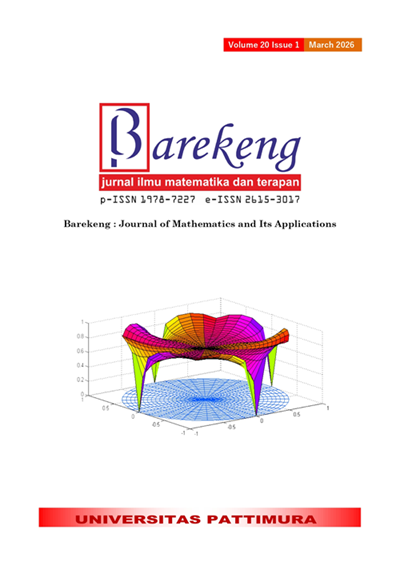ENHANCING LQ45 STOCK PRICE FORECASTING USING LSTM MODEL
Abstract
Stocks listed in the LQ45 index represent companies with high liquidity, large market capitalization, and strong fundamentals, making them pivotal to the movements of the Indonesian capital market. This study selects eight LQ45-listed stocks from the energy and mining sectors, as well as the banking sector. Historical data spanning a 10-year period from February 28, 2015, to February 28, 2025. This research aims to mitigate the impact of stock market dynamics, a significant challenge for investor decision-making. The Long Short-Term Memory (LSTM) method was employed to forecast stock prices using four variables: opening, highest, lowest, and closing prices. The LSTM architecture was chosen because its gated memory cells can effectively capture long‑term dependencies and nonlinear patterns in financial time series, thereby aligning with the research objective of minimizing forecasting error under volatile market conditions. Evaluation results using the Mean Absolute Percentage Error (MAPE) showed prediction errors below 2.5%, indicating relatively low forecasting error. Root Mean Squared Error (RMSE) values varied depending on stock price volatility. Companies exhibiting higher stock prices, such as Indo Tambangraya Megah Tbk (ITMG), demonstrate larger RMSE values. For opening prices, predictive accuracy was notably strong, with MAPE values consistently below 1.26%. This suggests that opening prices, influenced by pre-market sentiment and historical data, are more stable and easier to predict compared to other price variables.
Downloads
References
I. Gupta, T. K. Madan, S. Singh, and A. K. Singh, "HISA-SMFM: HISTORICAL AND SENTIMENT ANALYSIS BASED STOCK MARKET FORECASTING MODEL," J. Financ. Data Sci., vol. 8, no. 2, pp. 123–135, Mar. 2022.
A. Astuti, “ANALYSIS OF FACTORS INFLUENCING STOCK PRICES OF COMPANIES IN THE LQ45 INDEX: A STUDY PERIOD FROM 2019 TO 2022,” JASa (Jurnal Akuntansi, Audit dan Sistem Informasi Akuntansi), vol. 8, no. 2, pp. 409–419, Aug. 2024. doi: https://doi.org/10.36555/jasa.v8i2.2542
M. Agrawal, P. K. Shukla, R. Nair, A. Nayyar, and M. Masud, “STOCK PREDICTION BASED ON TECHNICAL INDICATORS USING DEEP LEARNING MODEL,” Computers, Materials and Continua, vol. 70, no. 1, pp. 287–304, 2021. doi: https://doi.org/10.32604/cmc.2022.014637
W. W. Hidayatullah and A. Anggraeni, “FACTORS AFFECTING STOCK PRICES OF LQ45 INDEX COMPANIES FOR THE 2017–2022 PERIOD,” Global Education Scientific Journal, vol. 4, no. 4, pp. 2463–2473, Dec. 2023. doi: https://doi.org/10.55681/jige.v4i4.1369
A. Jaboob, O. Durrah, and A. Chakir, “ARTIFICIAL INTELLIGENCE: AN OVERVIEW,” Synthesis Lectures on Engineering, Science, and Technology Engineering Applications of Artificial Intelligence, pp. 3–22, 2024. doi: https://doi.org/10.1007/978-3-031-50300-9_1
Y. L. Lin, C. J. Lai, and P. F. Pai, “USING DEEP LEARNING TECHNIQUES IN FORECASTING STOCK MARKETS BY HYBRID DATA WITH MULTILINGUAL SENTIMENT ANALYSIS,” Electronics (Switzerland), vol. 11, no. 21, Nov. 2022. doi: https://doi.org/10.3390/electronics11213513
M. L. Thormann et al., “STOCK PRICE PREDICTIONS WITH LSTM NEURAL NETWORKS AND TWITTER SENTIMENT,” Statistics, Optimization and Information Computing, vol. 9, no. 2, pp. 268–287, 2021. doi: https://doi.org/10.19139/soic-2310-5070-1202
W. Lu, J. Li, Y. Li, A. Sun, and J. Wang, “A CNN-LSTM-BASED MODEL TO FORECAST STOCK PRICES,” Complexity, vol. 2020, pp. 1-12, 2020. doi: https://doi.org/10.1155/2020/6622927
S. Wu, Y. Liu, Z. Zou, and T. H. Weng, “S_I_LSTM: STOCK PRICE PREDICTION BASED ON MULTIPLE DATA SOURCES AND SENTIMENT ANALYSIS,” Connection Science, vol. 34, no. 1, pp. 44–62, 2022. doi: https://doi.org/10.1080/09540091.2021.1940101
Statistics Indonesia (BPS), EXPORT COMMODITY ANALYSIS, 2019–2023: Agricultural, Forestry, and Fisheries Sector; Manufacturing Industry Sector; and Mining and Other Sectors, Jakarta: BPS, 2024.
S. J. Pipin, R. Purba, and H. Kurniawan, “STOCK PREDICTION USING RECURRENT NEURAL NETWORK (RNN-LSTM) WITH ADAPTIVE MOMENT ESTIMATION OPTIMIZATION,” Journal of Computer System and Informatics (JoSYC), vol. 4, no. 4, pp. 806–815, August 2023. doi: https://doi.org/10.47065/josyc.v4i4.4014
C. Janiesch, P. Zschech, and K. Heinrich, “MACHINE LEARNING AND DEEP LEARNING,” Adv. Data Anal., vol. 31, pp. 685–695, 2021. doi: https://doi.org/10.1007/s12525-021-00475-2
S. Hansun and J. C. Young, “PREDICTING LQ45 FINANCIAL SECTOR INDICES USING RNN-LSTM,” Journal of Big Data, vol. 8, no. 1, pp. 1-15, Dec. 2021. doi: https://doi.org/10.1186/s40537-021-00495-x
A. Wahab et al., “STOCK PREDICTION FOR INDONESIA STOCK EXCHANGE WITH LONG SHORT-TERM MEMORY,” Jurnal Ilmiah FIFO, vol. 16, no. 1, p. 96, Jun. 2024. doi: https://doi.org/10.22441/fifo.2024.v16i1.010
I. Botunac, J. Bosna, and M. Matetić, “OPTIMIZATION OF TRADITIONAL STOCK MARKET STRATEGIES USING THE LSTM HYBRID APPROACH,” Information (Switzerland), vol. 15, no. 3, pp. 1-15, Mar. 2024. doi: https://doi.org/10.3390/info15030136
M. Bansal, A. Goyal, and A. Choudhary, "STOCK MARKET PREDICTION WITH HIGH ACCURACY USING MACHINE LEARNING TECHNIQUES," Procedia Computer Science, vol. 215, pp. 247–265, 2022. doi: https://doi.org/10.1016/j.procs.2022.12.028
S. Razavi, “DEEP LEARNING, EXPLAINED: FUNDAMENTALS, EXPLAINABILITY, AND BRIDGEABILITY TO PROCESS-BASED MODELLING”, Environmental Modelling and Software, Vol. 144, art. no. 105159. 2021. doi: https://doi.org/10.1016/j.envsoft.2021.105159
A. S. Saud and S. Shakya, "ANALYSIS OF LOOK BACK PERIOD FOR STOCK PRICE PREDICTION WITH RNN VARIANTS: A CASE STUDY ON BANKING SECTOR OF NEPSE," Procedia Computer Science, vol. 167, pp. 788–798, 2020. doi: https://doi.org/10.1016/j.procs.2020.03.419
I. D. Mienye and T. G. Swart, “A COMPREHENSIVE REVIEW OF DEEP LEARNING: ARCHITECTURES, RECENT ADVANCES, AND APPLICATIONS,” Information, vol. 15, no. 12, p. 755, Nov. 2024. doi: https://doi.org/10.3390/info15120755
D. G. da Silva and A. A. de M. Meneses, “COMPARING LONG SHORT-TERM MEMORY (LSTM) AND BIDIRECTIONAL LSTM DEEP NEURAL NETWORKS FOR POWER CONSUMPTION PREDICTION,” Energy Reports, vol. 10, pp. 3315–3334, Nov. 2023. doi: https://doi.org/10.1016/j.egyr.2023.09.175
A. Al Bataineh and D. Kaur, “IMMUNOCOMPUTING-BASED APPROACH FOR OPTIMIZING THE TOPOLOGIES OF LSTM NETWORKS,” IEEE Access, vol. 9, pp. 78993–79004, 2021. doi: https://doi.org/10.1109/ACCESS.2021.3084131
J. Terven, D. M. Cordova-Esparza, A. Ramirez-Pedraza, E. A. Chavez-Urbiola, and J. A. Romero-Gonzalez, “LOSS FUNCTIONS AND METRICS IN DEEP LEARNING,” ArXiv, Jul. 2023.
R. A. Saleh and A. K. M. E. Saleh, “STATISTICAL PROPERTIES OF THE LOG-COSH LOSS FUNCTION USED IN MACHINE LEARNING,” arXiv preprint arXiv:2208.04564, Mar. 2024.
A. Arwansyah, S. Suryani, H. S. Y. Hasryif, A. Ahyuna, U. Usman, and S. Alam, “TIME SERIES PREDICTION MODEL USING DEEP CONVOLUTIONAL LSTM,” SISITI: Scientific Seminar on Information Systems and Information Technology, vol. 13, no. 2, pp. 1–10, August 2024.
Copyright (c) 2025 Marlina Setia Sinaga, Said Iskandar, Sudianto Manullang, Arnita Arnita, Faridawaty Marpaung, Fatizanolo Buulolo

This work is licensed under a Creative Commons Attribution-ShareAlike 4.0 International License.
Authors who publish with this Journal agree to the following terms:
- Author retain copyright and grant the journal right of first publication with the work simultaneously licensed under a creative commons attribution license that allow others to share the work within an acknowledgement of the work’s authorship and initial publication of this journal.
- Authors are able to enter into separate, additional contractual arrangement for the non-exclusive distribution of the journal’s published version of the work (e.g. acknowledgement of its initial publication in this journal).
- Authors are permitted and encouraged to post their work online (e.g. in institutional repositories or on their websites) prior to and during the submission process, as it can lead to productive exchanges, as well as earlier and greater citation of published works.






1.gif)



